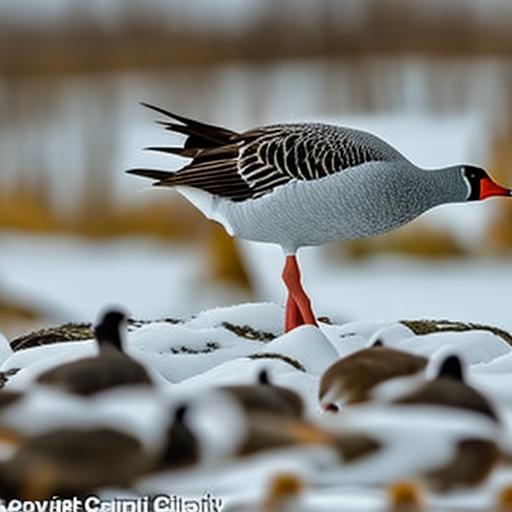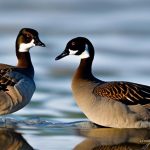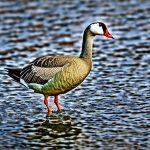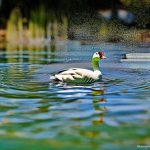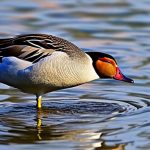Geese have a long and storied history, dating back thousands of years. They are believed to have originated in Europe and Asia, and were domesticated by the ancient Egyptians around 4,000 years ago. Since then, geese have been kept for a variety of purposes, including meat, eggs, feathers, and even as guard animals.
There are several different types of geese, each with their own unique characteristics. The most common types include the Toulouse, Embden, and Chinese geese. Toulouse geese are known for their large size and calm temperament, while Embden geese are prized for their white feathers and excellent meat quality. Chinese geese are smaller in size and known for their loud honking.
Keeping geese can provide a number of benefits. They are excellent grazers and can help control weeds and pests in your yard or garden. They also produce large eggs that are rich in nutrients, and their meat is lean and flavorful. Additionally, geese can make excellent guard animals, as they are naturally protective and will sound the alarm if they sense danger.
Key Takeaways
- Geese are a species that require special care in cold climates.
- Choosing the right breed of geese is important for their survival in winter.
- Proper housing and shelter are crucial for keeping geese safe and comfortable in winter.
- Feeding and nutrition must be carefully managed to meet the needs of geese in cold weather.
- Adequate water management is essential for geese to stay hydrated in freezing temperatures.
Climate Considerations: Understanding the Challenges of Keeping Geese in a Northern Climate
While geese are hardy animals that can tolerate a wide range of climates, they do face unique challenges when it comes to cold weather. Geese are adapted to living in temperate regions and have a layer of insulating fat under their skin that helps keep them warm. However, extreme cold temperatures can still pose a risk to their health.
Proper shelter and care are essential for keeping geese healthy in a northern climate. Geese should have access to a dry, draft-free shelter where they can seek refuge from the cold. This shelter should be well-insulated and provide adequate ventilation to prevent condensation and moisture buildup. It is also important to provide bedding material, such as straw or wood shavings, to help keep the geese warm and dry.
Common challenges faced by geese in cold climates include frostbite, hypothermia, and respiratory infections. Frostbite can occur when the temperature drops below freezing and the skin and tissues freeze. To prevent frostbite, it is important to keep the geese’s feet and legs dry and provide them with a warm, dry place to rest. Hypothermia can occur when a goose’s body temperature drops too low, and can be fatal if not treated promptly. Respiratory infections are also common in cold weather, as geese are more susceptible to illness when their immune systems are compromised.
Choosing the Right Breed: Identifying Geese that are Best Suited for Cold Weather
When choosing geese for a cold climate, it is important to select breeds that are well-suited to withstand the challenges of winter. Some breeds have thicker feathers and more insulating fat than others, making them better equipped to handle cold temperatures.
Popular breeds for cold climates include the Toulouse, Embden, and Pilgrim geese. Toulouse geese have a thick layer of insulating fat and dense feathers that help keep them warm in winter. Embden geese also have thick feathers and a layer of insulating fat, making them well-suited for cold climates. Pilgrim geese are known for their hardiness and adaptability, and can tolerate a wide range of climates.
When choosing a breed, it is important to consider factors such as size, temperament, and purpose. Some breeds are larger and more aggressive than others, while some are better suited for meat production or egg-laying. It is also important to consider the availability of breeders or hatcheries in your area, as some breeds may be more difficult to find than others.
Housing and Shelter: Creating a Safe and Comfortable Environment for Geese in Winter
Proper housing and shelter are essential for keeping geese safe and comfortable in a cold climate. Geese should have access to a dry, draft-free shelter where they can seek refuge from the cold. The shelter should be well-insulated and provide adequate ventilation to prevent condensation and moisture buildup.
There are several types of housing options for geese, including barns, sheds, and coops. Barns are a popular choice for larger flocks, as they provide ample space and protection from the elements. Sheds and coops are suitable for smaller flocks and can be easily modified to meet the needs of geese.
In addition to providing a warm shelter, it is important to keep the geese’s bedding clean and dry. Bedding material such as straw or wood shavings should be provided to help insulate the geese from the cold ground. It is also important to regularly clean the bedding to prevent the buildup of waste and bacteria.
Proper ventilation is crucial in a goose shelter, as it helps remove moisture and prevent the buildup of harmful gases. Ventilation can be achieved through windows, vents, or fans. It is important to ensure that the ventilation openings are large enough to allow for proper airflow, but small enough to prevent drafts.
Feeding and Nutrition: Meeting the Dietary Needs of Geese in a Cold Climate
Proper nutrition is essential for keeping geese healthy in a cold climate. Geese have specific dietary requirements that must be met in order for them to thrive.
In winter, geese require a diet that is high in energy to help them stay warm. This can be achieved by feeding them a balanced diet that includes grains, such as corn or wheat, as well as protein-rich foods, such as soybean meal or fish meal. It is also important to provide them with access to fresh water at all times.
Feeding geese in cold weather can be challenging, as their water sources may freeze. To prevent this, it is important to provide them with a heated water source or to regularly check and replace their water to ensure it does not freeze. It is also important to provide them with enough food to meet their energy needs, as they may require more calories in winter to maintain their body temperature.
Water Management: Ensuring Adequate Access to Clean Water in Freezing Temperatures
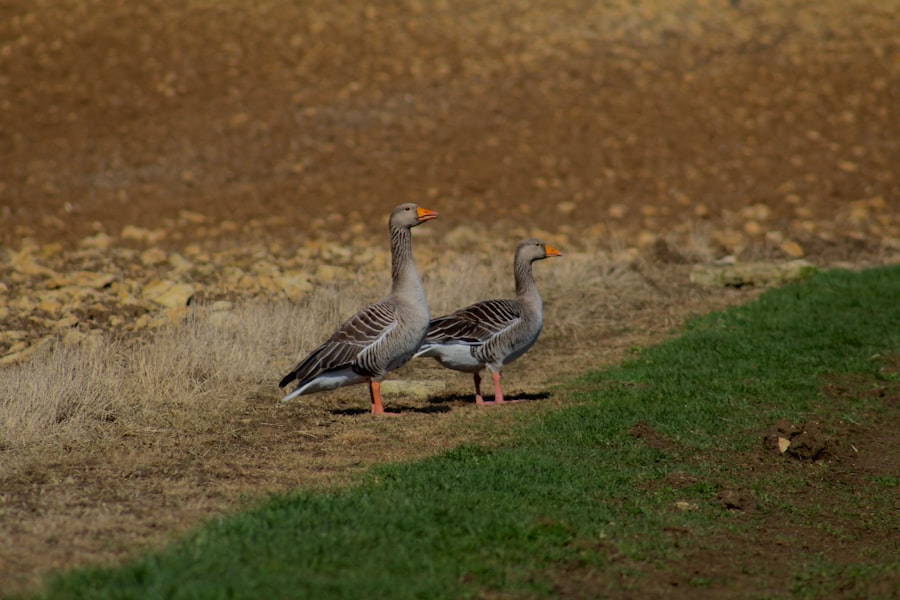
Water is essential for the health and well-being of geese, regardless of the season. However, in freezing temperatures, providing access to clean water can be a challenge.
Geese require water for drinking, bathing, and preening. In winter, it is important to ensure that their water does not freeze, as they can become dehydrated if they do not have access to water. There are several strategies for keeping water from freezing, including using heated waterers or adding a small amount of salt or sugar to the water.
It is also important to regularly clean and maintain the geese’s water sources to prevent the buildup of bacteria and algae. Water should be changed frequently and any debris or waste should be removed. Providing a shallow dish or container for the geese to bathe in can also help keep their feathers clean and healthy.
Health and Wellness: Preventing and Treating Common Ailments in Cold-Weather Geese
Geese are generally hardy animals that can tolerate a wide range of climates. However, they are still susceptible to certain health issues, especially in cold weather.
Common health issues in geese during winter include respiratory infections, frostbite, and hypothermia. Respiratory infections can occur when geese are exposed to cold drafts or damp conditions for extended periods of time. To prevent respiratory infections, it is important to provide them with a warm, dry shelter and ensure proper ventilation.
Frostbite can occur when a goose’s skin and tissues freeze due to prolonged exposure to cold temperatures. To prevent frostbite, it is important to keep the geese’s feet and legs dry and provide them with a warm, dry place to rest. Hypothermia can occur when a goose’s body temperature drops too low, and can be fatal if not treated promptly. Signs of hypothermia include shivering, lethargy, and a drop in body temperature. If you suspect a goose is suffering from hypothermia, it is important to warm them up slowly and seek veterinary care if necessary.
Exercise and Activity: Encouraging Physical Activity in Geese During the Winter Months
Exercise is important for the overall health and well-being of geese, regardless of the season. However, in winter, it can be challenging to keep geese active and engaged.
Geese are naturally active animals that enjoy grazing, foraging, and exploring their surroundings. In winter, when food sources may be limited, it is important to provide them with opportunities for physical activity. This can be achieved by providing them with a large outdoor space where they can roam and graze.
To encourage physical activity, it is also important to provide them with toys or objects to interact with. This can include things like balls, ropes, or even mirrors. These objects can help stimulate their natural instincts and keep them mentally and physically engaged.
Breeding and Reproduction: Strategies for Successful Breeding in a Northern Climate
Breeding geese in a cold climate can pose unique challenges. Cold temperatures can affect fertility rates and the health of goslings, making it important to take certain precautions.
One of the main challenges of breeding geese in cold weather is ensuring that the eggs stay warm enough to hatch. Geese typically lay their eggs in nests on the ground, which can be susceptible to freezing temperatures. To prevent this, it is important to provide the geese with a warm, dry nesting area that is protected from the elements.
Once the goslings hatch, it is important to provide them with a warm, dry environment. This can be achieved by using heat lamps or brooders to maintain a consistent temperature. It is also important to provide them with access to clean water and a balanced diet to ensure their growth and development.
Tips and Tricks for Keeping Geese Happy and Healthy in a Cold Climate.
Keeping geese in a cold climate can be challenging, but with the right knowledge and preparation, it can also be rewarding. By providing proper shelter, nutrition, and care, you can ensure that your geese stay happy and healthy throughout the winter months.
Some additional tips for keeping geese healthy and happy in winter include:
– Providing them with plenty of fresh water that is not frozen
– Regularly cleaning their bedding and shelter to prevent the buildup of waste and bacteria
– Monitoring their health closely and seeking veterinary care if necessary
– Providing them with opportunities for physical activity and mental stimulation
– Sharing your experiences and tips with other geese owners to learn from each other’s successes and challenges.
By following these tips and tricks, you can create a safe and comfortable environment for your geese in a cold climate, ensuring that they thrive year-round.
If you’re interested in keeping geese in a northern climate, you may also find this article on “How Long for Chicken Eggs to Hatch Naturally?” helpful. Understanding the incubation period for chicken eggs can provide valuable insights into the breeding process and help you ensure the successful hatching of your geese eggs. Check out the article here to learn more.
FAQs
What is the best breed of geese for a northern climate?
The best breed of geese for a northern climate is the Embden goose. They are hardy and can withstand cold temperatures.
What kind of shelter do geese need in a northern climate?
Geese need a shelter that is well-insulated and draft-free. It should also be large enough to accommodate all the geese and provide them with enough space to move around.
What kind of food do geese need in a northern climate?
Geese need a diet that is high in protein and fat to help them stay warm in cold temperatures. They also need access to fresh water at all times.
How do you keep geese from freezing in a northern climate?
To keep geese from freezing in a northern climate, provide them with a well-insulated shelter, plenty of food and water, and access to a heated water source. You can also provide them with extra bedding to help keep them warm.
What kind of predators do geese face in a northern climate?
Geese in a northern climate may face predators such as foxes, coyotes, and birds of prey. It is important to provide them with a secure shelter and to supervise them when they are outside.
How do you care for geese in the winter?
To care for geese in the winter, provide them with a well-insulated shelter, plenty of food and water, and access to a heated water source. You can also provide them with extra bedding to help keep them warm. It is important to check on them regularly to make sure they are healthy and safe.
Meet Walter, the feathered-friend fanatic of Florida! Nestled in the sunshine state, Walter struts through life with his feathered companions, clucking his way to happiness. With a coop that’s fancier than a five-star hotel, he’s the Don Juan of the chicken world. When he’s not teaching his hens to do the cha-cha, you’ll find him in a heated debate with his prized rooster, Sir Clucks-a-Lot. Walter’s poultry passion is no yolk; he’s the sunny-side-up guy you never knew you needed in your flock of friends!

